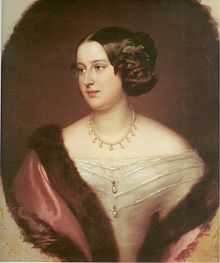Palazzo Ficquelmont-Clary
Coordinates: 45°25′49″N 12°19′28″E / 45.430197°N 12.324483°E

The Palazzo Ficquelmont-Clary (Ficquelmont-Clary Palace ) is a Late Renaissance Venitian palace facing the Giudecca Canal alongside the fondamenta Zattere by the ponte longo in Venice's Dorsoduro. It was originally built in the 17th century for a Venitian noble family. In the early 19th century, at a time Venice was part of the Austrian Empire, the palazzo became the Venitian residence of Franco-Austrian counts de Ficquelmont.
The palazzo is known as Palazzo Ficquelmont-Clary, named after its owners as the palace was bequeathed to count Charles-Louis de Ficquelmont's daughter and heiress, princess Elisex von Clary-Aldringen. The palazzo has remained in her descendants ownership to this day.
Description
.jpg)
Originally built in the late 17th century, during the vogue of the late Venitian Renaissance revival architecture, the palazzo underwent later remodelling in the 19th century but has kept its original style unchanged. The late Renaissance palace's façade onto the Zattere with its formal gate, topped with counts de Ficquelmont and princes Clary-Aldringen’s coat of arms’ bas-reliefs, has become a very recognizable landmark of Dorsoduro: it is one of the most magnificent of the district and surely the most noticeable of the Zattere.
The palazzo's architecture is typical of the Venitian Revival. It follows the Renaissance pattern of design on four floors: a hallway floor giving access to the palace from the fondamenta is surmounted by two Piano nobiles and a fourth story above them:
- - the primo piano nobile, typical of Venitian neo-Renaissance style, is made of decorated columns and eight monofora windows of which four are component of an open loggia with balcony, this floor is hosting magnificent ceremonial rooms;
- - the "secondo piano nobile" (secondary floor) has four monofora windows surrounding a large quadrifora closed loggia, it hosts more intimate reception spaces;
- - the fourth story is of much simpler exterior design, it has eight square windows without applied decoration.
The "U"-shaped back facade is made of two paralleled wings surrounding a large garden ending onto the back canal with a richly decorated crenated wall with arched gates to the Chiesa degli Ognissanti.
History


In the early 1840s, the palace was bought by famous Austrian statesman count Charles-Louis de Ficquelmont to be his family's Venitian residence. After his death the palace was bequeathed to his daughter and has remained in the ownership of her descendants, the princes Clary-und-Aldringen, to this day.
The palace played a major role throughout the 19th century as a European aristocratic stronghold, both politically and socially.
Count Charles-Louis de Ficquelmont was heir to an illustrious Lorrainer noble family dating back to the 11th century. Following the burst of the French Revolution he had immigrated in Austria soon becoming a central figure of Austrian diplomacy and politics. During the Revolutions of 1848, he succeeded Prince Metternich as acting Minister-President of the Austrian Empire. Due to his close ties with the "Metternich System" and the Russian tsar, popular feeling against him compelled him to resign on May 4. It was a violent period, his wife Countess Dolly, who was at their Venice's Palace at the time,[1] was arrested twice by the Venetian guarda civil and finally had to flee the city on board an English ship with her daughter, son-in-law and grandchildren.
However, after the Revolutionary period, the Ficquelmonts returned to their Venitian palace where Charles-Louis died in 1857.
On August 26, 1867, the palace hosted one of the aristocratic season's main event with the wedding of Austro-Hungarian aristocrat Countess Edmee von Clary und Aldringen, daughter of prince Edmund von Clary-und-Aldringen[2] and princess Elisex de Ficquelmont[3] and Italian nobleman Count Carlo Nicolis di Robilant e Cereaglio, son of count Maurizio Nicolis di Robilant e Cereaglio[4] and countess Maria Antonia von Waldburg Cappustigall.[5]
After World War II, while still the propriety of the princes Clary-und-Aldringen, part of the palace was rented to France to serve as the country's consulate general in Venice until it was moved to Trieste in the late 1990s.



Bibliography
- Guida d'Italia – Venezia, Touring Club Italiano, 1987, p. 451.
References
- ↑ Venetia was a part of the Austrian Empire
- ↑ son of prince Karl Joseph von Clary-und-Aldringen and countess Alyosa Chotek von Chotkowa und Wognin
- ↑ daughter of count Charles-Louis de Ficquelmont and of the Holy Roman Empire and countess Dolly von Tiesenhausen
- ↑ son of count Giambattista Nicolis di Robilant and countess Teresa Salmatoris Rossillion del Vilar
- ↑ daughter of count Friedrich Ludwig von Waldburg-Capustigall and princess Maria Antonia von Hohenzollern-Hechingen